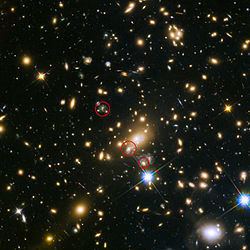Declination 22° 23′ 44.84″ | Spectral class Unknown Right ascension 11 49 35.45 | |
 | ||
Date 11 November 2014Patrick Kelly (GLASS) | ||
SN Refsdal is the first detected multiply-lensed supernova, visible within the field of the galaxy cluster MACS J1149+2223. It was given its nickname in honor of the Norwegian astrophysicist Sjur Refsdal, who, in 1964, first proposed using time-delayed images from a lensed supernova to study the expansion of the universe. The observations were made using the Hubble Space Telescope.
Contents
Einstein cross
The host galaxy of SN Refsdal is at a redshift of 1.49, corresponding to a comoving distance of 14.4 billion light-years and a lookback time of 9.34 billion years. The multiple images are arranged around the elliptical galaxy at z = 0.54 in a cross-shaped pattern, also known as an "Einstein cross".
When the four images fade away, astronomers predict they will have the rare opportunity to see the supernova again. This is because the current four-image pattern is only one component of the lensing display. The supernova may have appeared as a single image some 40–50 years ago elsewhere in the cluster field, and it is expected to reappear once more in about one year. The magnifications and staggered arrivals of the supernova images will help astronomers probe the cosmic expansion rate, as well as the distribution of matter and dark matter in the galaxy and cluster lenses.
Reappearance
The supernova Refsdal reappeared punctually at the predicted position between mid November 2015 and December 11, 2015 (with the exact date being uncertain by approximately one month which is the interval between two consecutive Hubble observations), in excellent agreement with the blind model predictions made before the reappearance was observed.
